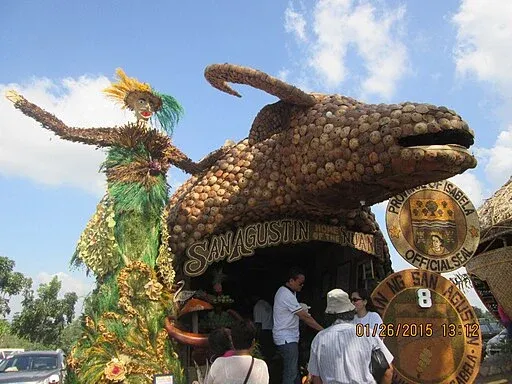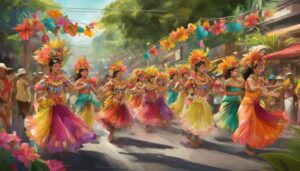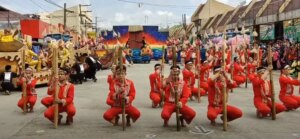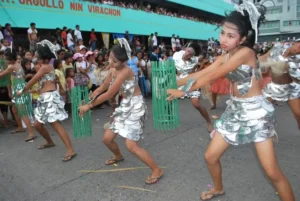
Bambanti_Festival_(Scarecrow_Festival)_in_Isabela
Image Source: Carmilynatienza, CC BY-SA 4.0, via Wikimedia Commons
The Bambanti Festival is an annual cultural and Thanksgiving festival held in the province of Isabela, Philippines every fourth week of January. It is also known as Isabela’s Scarecrow Festival, originating from the Ilocano word “bambanti” for scarecrow.
The festival was first launched in 1997 to celebrate the founding of Isabela and has become a significant event, recognized with awards like the Aliw Award for Best Festivals Practices and Performance. In 2019, it set a Guinness World Record for the most people dressed as scarecrows.
The festival showcases the province’s agricultural bounty, talents, and cultural heritage through various activities like street dances, contests, concerts, and culinary competitions. Isabela, known for its agricultural prowess, celebrates the festival to honor the previous year’s harvest, promote unity, preserve cultural heritage, and showcase local products and industries.
The festival was moved to January in 2011 for more favorable weather conditions and has since become a major event in the region, attracting participants from different towns and cities in Isabela.
Key Takeaways
- Bambanti Festival was launched in 1997 under Benjamin Dy’s leadership.
- Isabela achieved the Guinness World Record for most people dressed as scarecrows in 2019.
- Bambanti Festival activities include singing competitions, cultural shows, sporting events, and fundraising for charitable causes.
- Bambanti Village is a highlight of the festival, showcasing local products, handicrafts, and tourist attractions.
Facts About Bambanti Festival
| Facts | Explanation |
|---|---|
| Name of the Festival | Bambanti Festival |
| Type of Festival | Cultural Festival |
| City of Origin | Isabela |
| Festival Etymology | The word “bambanti” is an Ilocano term that means “scarecrow.” The festival is named after the iconic scarecrow figures that represent the province’s agricultural heritage and its primary crops, such as corn and rice. |
| Date When First Celebrated | February 1, 1997 |
| Founder of the Festival | Hon. Faustino G. Dy III |
| Brief History of the Festival | The Bambanti Festival was first celebrated in 1997 as a way to honor the province’s farmers and their contributions to the region’s agricultural industry. It aims to promote Isabela’s rich cultural heritage and showcase the province’s main products, particularly corn and rice. Throughout the years, the festival has grown into a grand celebration featuring various activities such as street dance competitions, agricultural exhibits, trade fairs, beauty pageants, and cultural presentations. It has become a significant event that attracts both local and foreign tourists to Isabela. |
| Brief History of the City | Isabela is a province located in the Cagayan Valley region of the Philippines. It was founded on May 1, 1856, by virtue of a Royal Decree issued by Queen Isabella II of Spain. The province is known for its vast agricultural lands, specifically producing rice and corn. Isabela also played a significant role during World War II as it served as a base of operations for Filipino and American forces against the Japanese occupation. Today, it is one of the country’s major agricultural provinces and a growing tourist destination. |
| Ethnic Information | Isabela is home to various ethnic groups, including the Ilocanos, Pangasinenses, Itawes, Gaddangs, and Malawegs. These ethnic communities have distinct traditions, languages, and cultural practices that contribute to the province’s diverse cultural heritage. |
| Location of the City in the Country | Isabela is situated in the northeastern part of Luzon Island in the Philippines. |
| How to Reach the City | By air: The nearest airport to Isabela is Cauayan Airport, which offers domestic flights from Manila. From the airport, you can take a taxi or a rented car to reach Isabela. |
| Nearby and Surrounding Cities or Towns | Ilagan to Ramon: 55.59 km Cabagan to Alicia: 72.35 km Roxas to San Mateo: 26.63 km San Mariano to San Manuel: 40.73 km Quezon to Naguilian: 40.18 km Echague to Salinungan: 18.69 km Burgos to Reina Mercedes: 16.11 km Jones to Munoz: 67.16 km Aurora to Angadanan: 28.89 km San Mateo to Cordon: 24.53 km |
| Google Map Link | Isabela City Location on Google Maps |
| Festival Main Events and Activities | 1. Street Dance Competition 2. Float Parade 3. Agri-trade Fair 4. Cultural Exhibits 5. Beauty Pageants 6. Concerts and Live Performances 7. Food Festivals 8. Parades and Processions 9. Fireworks Display 10. Agricultural Product Exhibitions |
| Other Famous Tourist Attractions in the City | 1. Magat Dam – A large reservoir located in Ramon, Isabela, known for its scenic views and water-based recreational activities. 2. Our Lady of the Pillar Parish Church – A historical church in Cauayan City known for its architectural beauty and religious significance. 3. Fuyot Springs National Park – A natural park in San Mariano, Isabela, featuring hot springs and lush greenery. 4. Ilagan Sanctuary – A wildlife sanctuary in Ilagan City that houses various animal species in their natural habitat. 5. Northern Sierra Madre Natural Park – A protected area spanning across several provinces, including Isabela, known for its biodiversity and stunning landscapes. |
| Famous Food Dishes of the City | 1. Pancit Cabagan – A local noodle dish made with stir-fried rice noodles, vegetables, and meat. 2. Pansit Batil Patong – Another noodle dish from Tuguegarao City made with flat noodles, topped with ground meat, chicharon, and egg. 3. Inabraw – A traditional Ilocano vegetable soup made with local vegetables and fish. 4. Dinakdakan – A grilled pork dish mixed with pig’s brain, vinegar, onions, and spices. 5. Pinakbet – A vegetable stew made with mixed vegetables and bagoong (fermented shrimp paste). |
| Landmarks in the City | 1. Isabela Provincial Capitol – The seat of government for the province of Isabela and an architectural landmark. 2. Santa Victoria Caves – A natural cave system located in Ilagan City with stunning rock formations. 3. San Pablo Church Ruins – Ruins of a Spanish-era church in San Pablo, Isabela that serves as a historical site. 4. Basilica Minore of Our Lady of Piat – A popular pilgrimage site in Piat, Isabela, known for its miraculous image of the Virgin Mary. 5. St. Matthias Church – A centuries-old church in Tumauini, Isabela, known for its unique architectural design using coral stones. |
| Why They Are Famous | -The Isabela Provincial Capitol is famous for its grand architecture and serves as a symbol of governance in the province. -Santa Victoria Caves are famous for their stunning rock formations and spelunking opportunities. -The San Pablo Church Ruins are famous for their historical significance as remnants of Spanish colonial times. -The Basilica Minore of Our Lady of Piat is famous for its miraculous image of the Virgin Mary attracting pilgrims from all over the country. -The St. Matthias Church is famous for its coral stone construction and unique architectural design. |
| Related Festivals (Closely and Directly Related) | 1. Panagbenga Festival (Baguio City) 2. Kadayawan Festival (Davao City) 3. Pahiyas Festival (Lucban, Quezon) 4. Sinulog Festival (Cebu City) 5. Ati-Atihan Festival (Kalibo, Aklan) |
Brief History of The Bambanti Festival & City
The Bambanti Festival, also known as Isabela’s Scarecrow Festival, is an annual celebration held in the province of Isabela, Philippines. But why is this festival celebrated? The answer lies in the rich history and agricultural heritage of Isabela.
The festival takes its name from the word “Bambanti,” which means scarecrow in the local Ilocano language. Scarecrows have long been used in farms to protect crops from birds.
Isabela, being a predominantly agricultural province, holds the highest rank in corn production, is second in rice production, and is the top producer of mung beans. Thus, scarecrows have become a symbol of Isabela’s agricultural success.
The first Bambanti Festival was launched in 1997 to commemorate the founding of Isabela. However, the festival faced several challenges and was deferred and halted for some years. It was then revived in 2011 under the leadership of Faustino G. Dy III and moved to January for more favorable weather conditions.
Moreover, Bambanti Village serves as an agri-trade fair where towns and cities in Isabela proudly display their local products, handicrafts, and tourist attractions. Another highlight is the Makan Ken Mainum festival, featuring local noodles made of cassava, corn, and rice (makan) and juices and fermented drinks produced locally (Mainum).
What Type of Festival is This
Bambanti is a scarecrow-themed festival, drawing its name from the Ilocano word for scarecrow, ‘Bambanti,’ which symbolizes the province’s agricultural roots.
Celebrated with grandeur, this festival showcases the rich cultural heritage of the Philippines through vivid costumes, elaborate scarecrow displays, dance competitions, and a variety of contests that stir the creativity of the locals.
You’ll experience a unique blend of tradition and innovation as each municipality brings forward its local products and crafts in Bambanti Village. The festival is not only a feast for the eyes but also a testament to the enduring spirit of the Isabelinos and their pride in their cultural heritage.
Ethnic Information Of The City & Region
You’ll find a diverse population in Isabela, with the majority of its residents descending from Ilocano, Tagalog, and Ifugao ethnic groups. The festival is more than just a celebration; it’s a living showcase of the region’s ethnic diversity, traditions, and unity.
The Ilocanos, known for their hard work and thrift, contribute to the agricultural backbone of the province, while the Tagalog and Ifugao communities bring their own unique customs and colorful heritage to the mix.
Festival Etymology
Why was the term ‘Bambanti’ chosen to represent Isabela’s cherished scarecrow festival? Well, ‘Bambanti’ is the Ilocano word for a scarecrow, which is deeply symbolic of the province’s agricultural roots. Scarecrows are ubiquitous in the fields of Isabela, standing guard over the crops and shooing away the birds.
They’re a farmer’s ally, crafted from simple materials to resemble human figures. The festival etymology reflects this connection to the land and its people.
Celebrating the Bambanti honors the tireless efforts of local farmers and their ingenuity in safeguarding their livelihoods.
The History and Significance Of The City Of Isabela & Bambanti Festival
Why “Bambanti Festival” is Celebrated
The Bambanti Festival is celebrated in Isabela, Philippines, as a way to honor the province’s agricultural heritage and the contributions of its farmers. The festival takes its name from the word “bambanti,” which means scarecrow in the local Ilocano language. Scarecrows are symbolic of the province’s agricultural success, as Isabela is a major producer of corn, rice, and mung beans.
The festival was first launched in 1997 to commemorate the founding of Isabela and has since grown into a grand celebration featuring various activities that showcase the region’s rich cultural heritage and agricultural industry.
History of The City Of Isabela, Philippines
Isabela, the second largest province of the Philippines in terms of land area, is located in the Cagayan Valley region in Luzon. Its history is marked by several key events and influences:
- Pre-Colonial Period: Before the Spanish colonization, the area was inhabited by indigenous groups such as the Gaddangs, Ibanags, and Yogads.
- Spanish Era: In the 18th century, the Spaniards began to explore and establish missions in the Cagayan Valley. Isabela was founded on May 1, 1856, when the province was carved out from Cagayan and Nueva Vizcaya by a Royal Decree. The province was named in honor of Queen Isabela II of Spain.
- American Period: Following the Spanish-American War, the Philippines was ceded to the United States. During American colonial rule, the government continued to develop Isabela, building roads and introducing cash crops like tobacco and corn.
- World War II: Isabela was occupied by Japanese forces during World War II and later liberated by Filipino and American troops.
- Post-War Development: After the war, rehabilitation and development efforts took place. Agriculture continued to be the main economic activity, with Isabela becoming a major producer of rice and corn.
- Contemporary Period: Today, Isabela is known not only for its agricultural contributions but also for its renewable energy developments and ecotourism destinations. It has become one of the most progressive provinces in the Cagayan Valley region.
Location of the City In The Country
Isabela is located in the northeastern part of Luzon, which is the largest island in the Philippines.
It is bordered by the Pacific Ocean to the east and is surrounded by the provinces of Cagayan to the north, Quirino and Aurora to the south, and Kalinga and Mountain Province to the west.
Isabela is strategically positioned as a crossroads of culture and biodiversity in the country.
Here’s a glance at Isabela’s location:
| Boundary | Neighbor |
|---|---|
| North | Cagayan |
| South | Quirino, Aurora |
| East | Pacific Ocean |
| West | Kalinga, Mt. Province |
How To Reach The City Of Isabela For Bambanti Festival
To reach Isabela City in the Philippines, you can use several modes of transportation depending on your starting location and your preferences. Here are some common ways to get there:
From Manila (Capital of the Philippines):
By Air:
- Book a flight from Ninoy Aquino International Airport (NAIA) in Manila to Cauayan Airport (CYZ) in Isabela.
- Upon arriving at Cauayan Airport, take a taxi or rent a car to Isabela City.
By Land:
- Go to bus terminals in Metro Manila that offer trips to Cagayan Valley.
- Board a bus heading to Isabela. Buses may take you directly to Isabela City or nearby towns.
- From the drop-off point, you may need to take a jeepney or tricycle to reach your specific destination within Isabela City.
From Other Parts of Luzon:
By Land:
- If you’re coming from other parts of Luzon, you can either drive or take a bus heading towards Isabela. The North Luzon Expressway (NLEX) and Subic-Clark-Tarlac Expressway (SCTEX), followed by the Tarlac-Pangasinan-La Union Expressway (TPLEX), will lead you to Isabela.
Within the Region:
- For those nearby, local buses, jeepneys, and vans commonly serve routes to and from various towns and cities within the Cagayan Valley region to Isabela City.
Please note that travel times and available transportation options might vary, so it’s advisable to check the latest schedules and book tickets (if necessary) in advance.
Nearby Cities or Towns & Their Distance
You’ll find Isabela’s Bambanti Festival nestled among neighbouring cities and towns, with Tuguegarao approximately 68 kilometers to the north and Santiago around 79 kilometers to the south.
These nearby locations add to the richness of tourism in Isabela, making it a hub for travelers who indulge in the vibrant celebrations in the Philippines.
| City/Town | Distance (km) |
|---|---|
| Tuguegarao | 68 |
| Santiago | 79 |
| Cauayan | 34 |
| Ilagan (Provincial Capital) | 16 |
Festival main events and activities
The Bambanti Festival showcases the culture, heritage, and agricultural abundance of the province. Here are some main events and activities typically associated with the Bambanti Festival:
- Grand Parade: The festival kicks off with a grand parade featuring colorful floats, street dancers, marching bands, and participants dressed in vibrant costumes. The parade showcases the different aspects of Isabela’s culture and traditions.
- Street Dancing Competition: One of the highlights of the festival is the street dancing competition. Various groups from different municipalities in Isabela participate in this competition, showcasing their choreographed dances that depict the rich agricultural heritage of the province.
- Agri-Trade Fair: An agri-trade fair is set up during the festival, where local farmers and entrepreneurs showcase their agricultural products, handicrafts, and other locally-made products. It provides an opportunity for visitors to learn about Isabela’s agricultural industry and purchase unique products.
- Bambanti Village: A dedicated area called the Bambanti Village is set up to showcase the best of Isabela’s agriculture, culture, and tourism. It features exhibits, demonstrations, and interactive activities related to farming practices, traditional crafts, and local delicacies.
- Cultural Performances: Throughout the festival, there are cultural performances that showcase traditional music, dances, and theatrical presentations. These performances highlight the cultural diversity and talent of the people of Isabela.
- Beauty Pageant: The festival also includes a beauty pageant called “Mutya ng Bambanti” (Muse of the Scarecrow) where contestants compete for the title. The pageant aims to promote beauty, talent, and intelligence while representing the agricultural heritage of Isabela.
- Sports Events: Various sports events are organized as part of the festival to promote physical fitness and camaraderie among participants. These events may include basketball tournaments, fun runs, and other sports activities.
Please note that the specific events and activities may vary from year to year.
Popular Food Dishes of The City
You can find a variety of popular food dishes that highlight local ingredients and flavors. Some of the popular food dishes of Isabela during the Bambanti Festival include:
- Pancit Cabagan: This is a type of noodle dish that originated from the town of Cabagan in Isabela. It is made with stir-fried noodles, and vegetables, and topped with crispy pork or chicken.
- Inatata: Inatata is a traditional dish of Isabela made from grilled or roasted native chicken. The chicken is marinated in spices and cooked over an open fire, giving it a smoky flavor.
- Pancit Batil Patung: Pancit Batil Patung is a unique noodle dish that originated from Tuguegarao City in Cagayan Province, which is near Isabela. It consists of stir-fried egg noodles topped with sautéed meat, vegetables, and a sunny-side-up egg.
- Lechon: Lechon is a popular Filipino dish consisting of a whole roasted pig. During the Bambanti Festival, you can find lechon stalls offering deliciously seasoned and roasted pigs.
- Pinakbet: Pinakbet is a vegetable dish made from a combination of different vegetables such as bitter melon, eggplant, squash, and okra. It is cooked with shrimp paste and sometimes includes pork or shrimp for added flavor.
These are just some of the popular food dishes you can enjoy during the Bambanti Festival in Isabela. The festival provides a great opportunity to explore and savor the local cuisine of the region.
| Dish | Main Ingredients | Description |
|---|---|---|
| Pancit Cabagan | Noodles, soy sauce | Savory stir-fried noodle specialty |
| Inatata | Glutinous rice | Sweet snack paired with beverages |
| Sinanta | Noodles, seafood | Flavorful soup with local twists |
| Chicharabao | Carabao skin | Crunchy, salty snack favorite |
Tips for attending the Bambanti Festival
If you’re planning to join the vibrant Bambanti Festival in Isabela, it’s essential to keep a few tips in mind for an unforgettable experience.
- First off, familiarize yourself with the schedule of Bambanti festival activities to maximize your time. There’s a plethora to enjoy, from street dances to cultural shows, so plan your itinerary accordingly.
- Don’t forget to wear comfortable footwear since you’ll be on your feet a lot, exploring and dancing.
- When it comes to Bambanti festival costumes, immerse yourself in the local culture by donning a scarecrow-inspired outfit.
Remember, in 2019, Isabela set a world record for this! But above all, maintain an open mind and respect the customs. Engage with locals, try new foods, and let the festival’s spirit move you!
Famous Tourist Spots in the City
Here are some famous tourist spots in the city of Isabela:
- Isabela Provincial Capitol: The Provincial Capitol is a prominent landmark in Isabela. It features grand architecture and serves as the seat of the provincial government.
- Basilica Minore of Our Lady of the Visitation: This beautiful church is located in the municipality of Agoo. It is known for its stunning architecture and houses the miraculous image of Our Lady of the Visitation.
- Magat Dam: The Magat Dam is a major tourist attraction in Isabela. It is one of the largest dams in the Philippines and offers a picturesque view of the surrounding mountains and reservoirs.
- Sierra Madre Mountain Range: Isabela is blessed with the majestic Sierra Madre Mountain Range. Nature enthusiasts can explore its lush forests, scenic trails, and stunning waterfalls.
- Santa Victoria Caves: Located in the municipality of Santo Tomas, the Santa Victoria Caves are a natural wonder worth exploring. These limestone caves feature impressive rock formations and underground rivers.
- Dicotcotan Beach: For those seeking a beach getaway, Dicotcotan Beach in Maconacon is a must-visit. It boasts pristine white sand, crystal-clear waters, and a tranquil atmosphere.
- San Pablo Church Ruins: The San Pablo Church Ruins in the town of Isabela are remnants of a Spanish-era church destroyed during World War II. It serves as a historical site and offers a glimpse into the region’s past.
- Palanan Bay: Palanan Bay is known for its unspoiled beauty and rich biodiversity. It offers opportunities for swimming, snorkeling, and exploring its diverse marine life.
These are just a few of the many tourist spots that Isabela has to offer. Each destination showcases the natural beauty, rich history, and cultural heritage of the city.
| Tourist Spot | Description |
|---|---|
| Magat Dam | Agro-industrial powerhouse |
| Isabela Provincial Capitol | Seat of local history and governance |
| Ilagan Sanctuary | A biodiversity hotspot |
| Tumauini Church | An ecclesiastical heritage |
Famous Landmarks in the city
The City of Isabela, also known as Isabela City, is located in the province of Basilan in the Philippines. While Isabela City may not be as well-known internationally as other cities in the Philippines, it does have some notable landmarks and attractions. Here are a few famous landmarks in Isabela City:
- Malamawi Island: Located just off the coast of Isabela City, Malamawi Island is known for its beautiful beaches and crystal-clear waters. It is a popular destination for swimming, snorkeling, and diving.
- Basilan Provincial Capitol: The Basilan Provincial Capitol is a government building located in Isabela City. It is an architectural landmark and serves as the seat of the provincial government.
- Sta. Isabel Cathedral: The Sta. Isabel Cathedral is the main Catholic church in Isabela City. It is a beautiful structure with a rich history and serves as a spiritual and cultural center for the local community.
- Plaza Rizal: Plaza Rizal is a public square located in the heart of Isabela City. It features a statue of national hero Jose Rizal and is a popular gathering place for locals and tourists.
- Malagandis Falls: Located just outside of Isabela City, Malagandis Falls is a picturesque waterfall surrounded by lush greenery. It is a popular spot for picnics and nature walks.
These are just a few of the famous landmarks in Isabela City. The city also has other attractions such as parks, museums, and historical sites that are worth exploring.
| Landmark | Description |
|---|---|
| Magat Dam | One of Asia’s largest dams |
| Tumauini Church | A unique cylindrical brick church |
| Bambanti Village | The heart of Isabela’s Bambanti festival with local crafts and foods |
Absorb the region’s rich heritage as you wander through these unforgettable places.
Related festivals in the same region
In the region of Isabela, where the Bambanti Festival is a well-known event held annually in the last week of January, several other festivals celebrate the rich cultural heritage and agricultural bounty of the province. Here are some related festivals in the same area:
- Pagay Festival: Celebrated in the municipality of Alicia, this festival takes place on September 28. It is a celebration of the rice harvest and Alicia’s position as a major rice producer in the province.
- Nateng Festival: Held in the town of Mallig from April 6-8, this festival showcases the local tuber, ‘nateng,’ through various culinary delights and cultural presentations.
- Gakit Festival: In Angadanan, this event is characterized by the fluvial procession of bamboo rafts (‘gakit’) along the Cagayan River, reflecting the town’s riverine culture and traditions.
- Baka Festival: This festival celebrates the cattle industry, a significant economic driver in some areas of Isabela.
- Balatong Festival: A festival dedicated to ‘balatong’ or mung beans, emphasizing the importance of legumes in local agriculture and cuisine.
- Binallay Festival: This event focuses on ‘binallay,’ a local delicacy made from glutinous rice and coconut cream, highlighting Isabela’s culinary traditions.
- Binnadangan Festival: It is a celebration that promotes unity among locals and showcases indigenous games and practices.
- Dikit Festival: Celebrates ‘Dikit,’ a variety of sticky rice that is a staple in the region’s cuisine.
- Gawagaway-yan Festival: A cultural and religious celebration that includes street dancing, agricultural trade fairs, and other festivities reflecting the history and traditions of Isabela’s people.
Each of these festivals offers a unique glimpse into the local customs, agricultural practices, and communal spirit of Isabela’s towns and municipalities. They provide an array of entertaining and engaging activities, from street dances and parades to agricultural shows and food competitions.
| Festival Name | Location | Highlights |
|---|---|---|
| Pattaradday Festival | Santiago City | Convergence of diverse ethnic groups |
| Panagdadapun Festival | Quirino | Commemoration of provincehood |
| Gawaygaway-yan Festival | Cauayan City | Agricultural thanksgiving |
| Gawagaway-yan Festival | Isabela | Cultural shows and street dancing |
What Are the Similarities Between the Bambanti Festival and the Bayluhay Festival in the Philippines?
The Bambanti Festival and Bayluhay Festival in the Philippines bear resemblances in terms of their cultural significance of Bayluhay. Both festivals celebrate the rich heritage and traditions of the Filipino people, showcasing their agricultural roots and indigenous customs.
These festivals serve as platforms for preserving and promoting local culture, fostering a sense of pride and unity among communities. Furthermore, they attract tourists from around the world, contributing to the cultural exchange and tourism industry in the Philippines.
Summary Of Bambanti Festival
| Category | Information |
|---|---|
| Name | Bambanti Festival |
| Celebration | Culture, Harvest, Thanksgiving, Scarecrow |
| Country | Philippines |
| Date | Fourth week of January |
| Duration | 1 week |
| Established | 1997 |
| Location | Isabela |
| Organizer | Provincial Government of Isabela |
| Other Names | Isabela’s Scarecrow Festival |
| Historical Facts | – Bambanti Festival originates from the word “bambanti,” which means scarecrow in the Ilocano language. – The festival was first launched in 1997 to celebrate the founding of Isabela. – Isabela was created from the provinces of Cagayan and Nueva Vizcaya on May 1, 1856. – The festival was revived and moved to January in 2011 under Faustino G. Dy III. – In 2019, Isabela achieved the Guinness World Record for the most number of people assembled dressed as scarecrows. |
| Festival Activities | – Singing Idol and Glee – Chorale show and contests – Medical mission – Sporting events – Fun run – Fund-raising for charitable causes – Concerts, entertainment, and cultural shows – Fireworks display – Street dance – Festival dance showdown – Contests for scarecrow puppets, dress-ups, and installations |
| References | Business World Malaya Business Insight Philippine Statistics Office Provincial Government of Isabel The Manila Times Philippine News Agency ABS-CBN News Manila Bulletin Rappler |
Note: Please click on the links provided to access more information about each item.
Related References About Bambanti Festival
| Reference | Link |
|---|---|
| Bambanti Festival 2019: From Aliw Awards to a Guinness World Record | Business World |
| Delos Reyes, Anton. Smiling scarecrows at the Bambanti Festival | Malaya Business Insight |
| Isabela: Most Populated Province in Cagayan Valley | Philippine Statistics Office |
| History and Culture. Provincial Government of Isabel | Provincial Government of Isabela |
| Visaya, Vince Jacob A. Bambanti festival deemed a success | The Manila Times |
| Soliven, Benito. Bambanti Festival shows Isabela’s history and heritage | The Philippine Star through Pressreader |
| Merlito, Edale. Week long 2018 Bambanti festival begins | Philippine News Agency |
| Garcia, Angelo. Bambanti showcases Isabela’s produce, food, people | ABS-CBN News |
| January 27 is a special non-working day in Isabela | Manila Bulletin |
| Villano, Alex. Isabela’s Bambanti festival is not just about scarecrows | Rappler |
Final Thoughts
The Bambanti Festival in Isabela, Philippines, is a lively celebration of the province’s agricultural heritage and community spirit. It started in 1997 and has since become a unifying event that showcases the region’s cultural diversity.
With colourful parades, scarecrow-inspired costumes, cultural performances, and agricultural exhibits, the festival highlights the resilience and creativity of the Isabelinos. It represents various ethnic groups and leaves a lasting impression on locals and visitors alike.
Frequently Asked Questions
Are There Specific Traditions or Rituals Performed by the Locals During the Bambanti Festival That Are Not Part of the Public Events?
Yes, locals might have personal rituals, like preparing family scarecrows, that aren’t showcased publicly but are integral to their cultural celebration. These add depth to the communal events.
How Do the Farmers of Isabela Incorporate Modern Agricultural Practices With the Traditional Symbolism of the Bambanti (Scarecrow) During the Festival?
You’re blending modern farming techniques with age-old symbols by creatively integrating scarecrows into high-tech agricultural practices, showcasing innovation while honouring tradition at this unique celebration. It’s a harmonious fusion of the past and future.
What is the Bambanti Festival?
The Bambanti Festival is an annual cultural and Thanksgiving event celebrated in Isabela, Philippines, during the fourth week of January. It’s known as Isabela’s Scarecrow Festival and features a week-long celebration that includes a variety of activities such as agricultural trade fairs, street dances, beauty pageants, and culinary competitions. The festival celebrates the province’s agricultural heritage and showcases the creativity and unity of its people.
Why is it called the Bambanti Festival?
“Bambanti” is the Ilocano word for “scarecrow,” which symbolizes the guardians of the fields in Isabela, a province known for its agricultural prowess. The festival celebrates the importance of scarecrows in protecting crops and has evolved to include giant scarecrow installations, representing the strength and unity of the Isabela community.
What are the highlights of the Bambanti Festival?
Key highlights include the Giant Bambanti Showcase, with large scarecrow installations; street dances and performances that light up the nights; a Mardi Gras parade showcasing Isabela’s culture; and a culinary journey featuring local cuisines like Pancit Cabagan and Binallay. Additionally, the festival features a variety of contests and activities, including a prestigious Queen Isabela beauty pageant.
How can visitors participate in the Bambanti Festival?
Visitors are encouraged to attend during the last week of January to experience the full range of activities. There are accommodations available in Isabela, ranging from luxury hotels to guesthouses, with recommendations to book in advance due to the festival’s popularity. Isabela is accessible by air via Cauayan Airport or by land, with various local transport options available for getting around the province.







